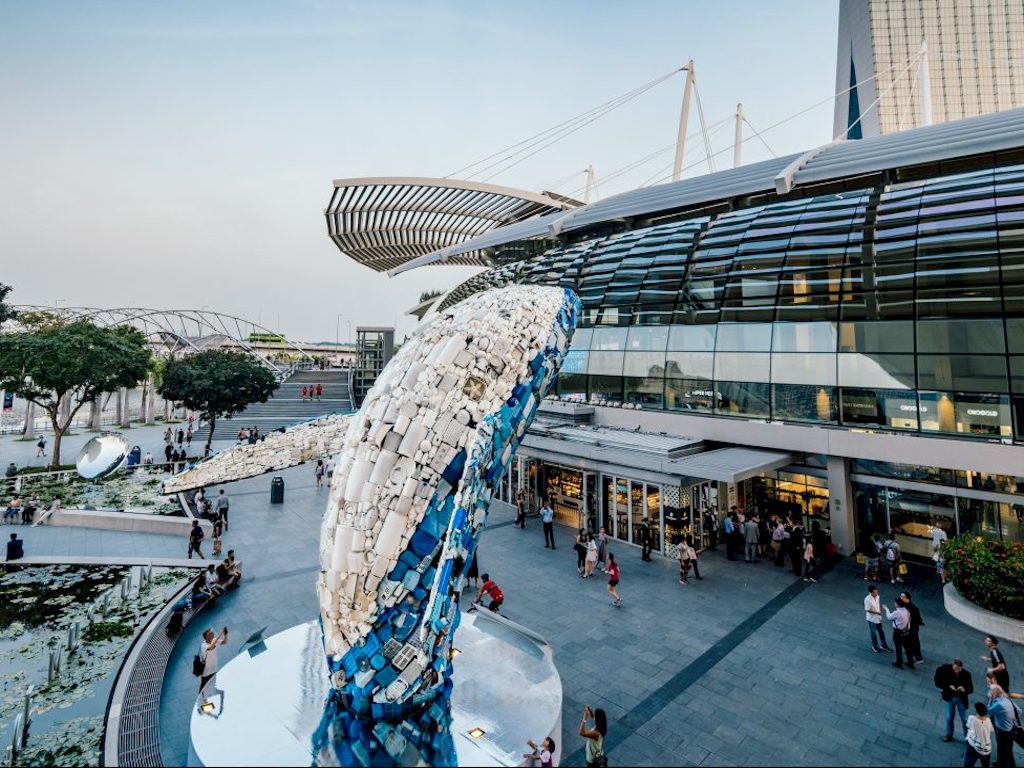3 Mins Read
A sculpture made from recovered ocean plastic waste and steel support, “Skyscraper” (The Bruges Whale) has begun its Asian Migration Tour in collaboration with Ocean Recovery Alliance, starting in Singapore at the ArtScience Museum of Marina Bay Sands. Designed by Jason Klimoski and Lesley Chang from New York’s StudioKCA, the 4-storey tall piece was inspired by the “liquid city” of the ocean and was created for the 2018 Bruges Triennial using over 5 tonnes of plastic waste collected by the Hawaii Wildlife Fund. The aim of the Asian tour installation, titled “Have we breached the limit?” is to show the severity of the ocean plastic crisis, and motivate change in our everyday consumption habits.
“Skyscraper”, which was originally installed in the canal at Jan Van Eyck Plein, was the centerpiece of the 2018 Bruges Triennial, which attracted over 380,000 people to the installation, and later moved to Utrecht in 2019 as a part of an educative campaign on marine plastic waste. The 11-metre tall sculpture, supported by an internal steel structure, is made from 5 tonnes of recovered ocean plastic waste from the Pacific Ocean that was collected by the Hawaii Wildlife Fund over 4 months. The plastic used included all types of waste, from hangers and kitchen bowls to toilet seats and car bumpers.
Now, in partnership with the Hong Kong-based NGO Ocean Recovery Alliance, the sculpture designed by StudioKCA’s Jason Klimoski and Lesley Chang has embarked on an Asia-Pacific Migration Tour to illustrate the impact of 150 million tonnes of plastic waste pollution in our oceans. The first stop is Singapore, where the iconic Skyscraper will be showcased at the ArtScience Museum of Marina Bay Sands until late December before embarking on its next destination. The installation, dubbed “Have we breached the limit?” hopes to unite key Asian cities with a common cause to better tackle the global plastic pollution crisis.
Speaking about the meaning behind the sculpture, Lesley Chang said: “We created Skyscraper to serve as a physical example of why we need to change how we use and dispose of plastic in the world today.”
The installation comes as multiple reports have raised awareness about the severity of ocean plastic waste in Asia-Pacific, the largest source of plastic ocean leakage in the world. In a September Ipsos report, analysts revealed that Vietnam’s waste had jumped by 10 fold within just 3 decades. Another report, penned by local and international NGOs, exposed the severity of global environmental injustice in Indonesia, where tofu makers are burning plastic waste to fuel furnaces.
Amid these sobering facts, a number of initiatives are targeting the region for change in a number of ways. Sungai Watch, for instance, is a new campaign launched by Balinese media platform Make A Change World, which will see 100 trash barrier booms installed across the island’s rivers to combat plastic pollution. On the other hand, Singapore-based venture management company Circulate Capital has just launched the world’s first investment fund dedicated to alleviate the net financing gap for plastic waste to be collected and recycled across the five biggest ocean polluters in the world, all located in Asia.
Lead image courtesy of Ocean Recovery Alliance.




